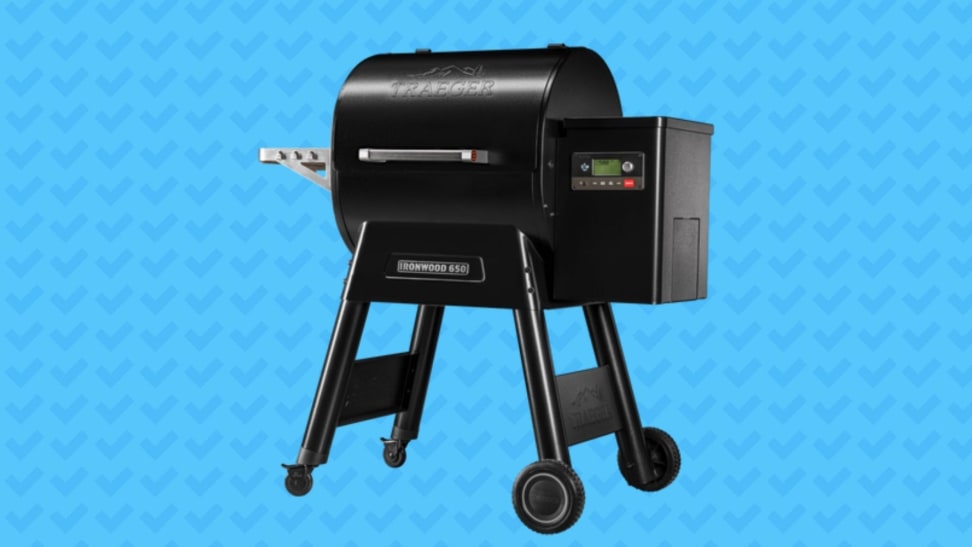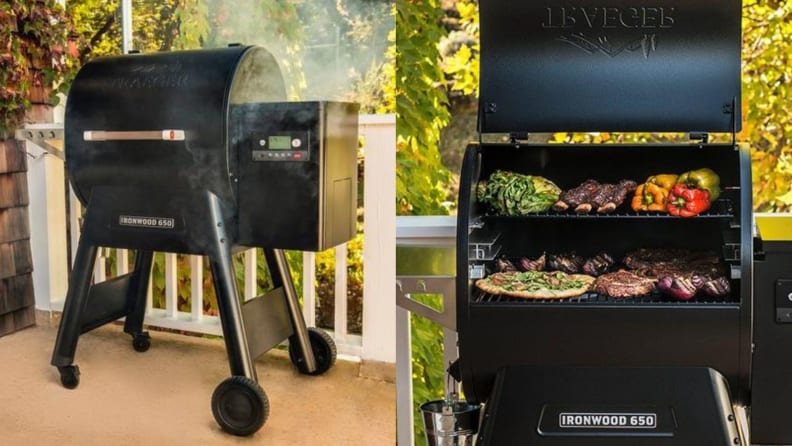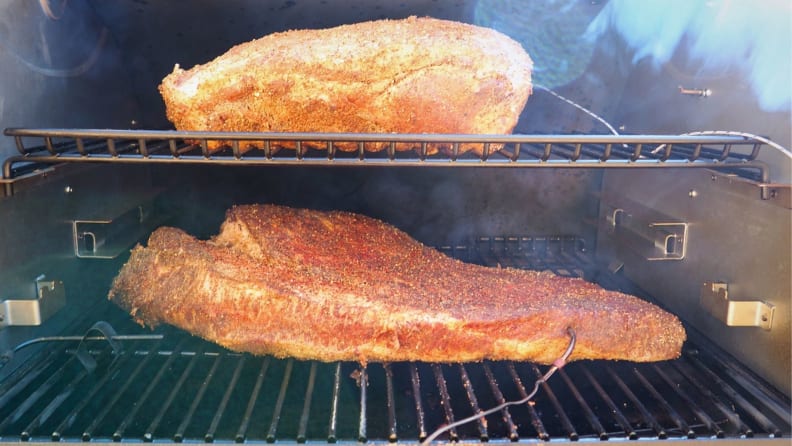This wood pellet grill is perfect for backyard chefs
We put the Traeger Ironwood 650 pellet grill to the test.

 Credit:
Reviewed / Traeger
Credit:
Reviewed / Traeger
Products are chosen independently by our editors. Purchases made through our links may earn us a commission.
I bought a Traeger grill in 2013 after a very failed backyard experiment. I'd tried to hack my charcoal grill to turn it into a smoker, and it might have worked if I wasn’t trying to smoke a gigantic pork shoulder.
Several hours into the 10- to 12-hour cooking session, I realized the charcoal had gone out, and I had no idea how long the still-very-raw shoulder had been sitting on a cold grill. I headed to Costco the next day and picked up a pellet grill that promised set-it-and-forget-it functionality.
Traeger grills have come a long way since then, adding a more robust control panel, building in WiFi capabilities, and upgrading their controllers and fans for improved heat and smoke distribution. But the price has also increased, and my $400 purchase is definitely a thing of the past. Today, Traeger’s entry-line grills are easily double that, and a brand-new Traeger Ironwood 650 pellet grill and smoker will run you $1,300.
I’ve tested dozens of gas, charcoal, and electric grills over the years, including several smokers under $500.
These value-priced smokers might not have many bells and whistles, but they all created incredible-tasting food. So I wondered if the Traeger Ironwood 650’s high price tag could possibly be worth it. After spending a week with this WiFi-capable grill, there’s one thing I can say for certain: using a Traeger makes the smoking process significantly easier.
About Traeger grills

A Traeger grill produces heat by burning pellets made from compressed wood.
Traeger has become synonymous with wood pellet grills because it was the only name in the game for decades. The thing that makes a Traeger so appealing is its ease of use. Pellet grills are fueled by wood pellets but powered by electricity, so there’s no need to fiddle with dials or vents to reach the desired temperature like you would with gas or charcoal.
Simply ensure the hopper is full of pellets, select the temperature from the control panel, and let the grill do all the work. Traeger’s new WiFi-enabled models make things even easier, allowing you to adjust the temperature from the couch.
How does a Traeger grill work?
A Traeger grill produces heat by burning pellets made from compressed wood. These pellets are either made with 100% hardwood or contain flavorful food-grade oils (depending on the brand). To ignite a Traeger grill, the pellets are loaded into a hopper on the side of the grill.
An electric-powered auger moves the pellets into the firepot below the grill grates, where the pellets ignite to release heat and smoke. A drip pan plate keeps the flames from gaining direct access to the food cooking above, and a fan disperses the heat and smoke to create indirect heat similar to a convection oven.
When the grill reaches the set temperature, the auger slows to drop fewer pellets into the pot to maintain the heat. You can adjust the heat or the smoke level using the control panel or Traeger’s WiFIRE app.
At low temperatures, the pellets will smoke and smolder to infuse smoky flavors into the food, similar to what you’ll find when grilling over wood or charcoal. When these grills are used at higher temperatures, less smoke is produced, and the firepot focuses on creating heat.
Traeger grill’s cap out at a maximum temperature of 500°F, which isn’t far off from gas grills (which often cap at 550°F). Since the drip pan plate prevents direct searing and grill marks, the food crisps up like it would when roasted inside a high-temperature oven.
How long do Traeger grills last, and why are they so expensive?

We wanted to see how the Traeger Ironwood 650 could handle cooking tough cuts of meat at low temperatures.
While some pellet grills can be found under $500, most range between $1,000 and $2,000 depending on the size and features. They have more moving parts than other types of grills, and controlling the temperature is a bit more complicated than a grill that uses dials or vents. The thermostat and an onboard computer control the grill’s auger, fan, and ignition system.
If it doesn’t come together correctly, the automated pellet delivery system will fail to deliver pellets to the firepot, and the grill won’t reach appropriate heat levels. Worse yet, the grill could turn off mid-session, or the ignited pellets can back up into the hopper, creating a dangerous situation.
Modern pellet grills are also smart-capable. They have built-in probe thermometers that connect to smartphones via Bluetooth or WiFi, allowing users to monitor long-cooking items like brisket or pulled pork remotely. Traeger’s WiFIRE app also allows you to change the temperature, activate their Super Smoke function, set a timer, monitor the pellet level in the hopper, and turn the grill off. That’s convenient, but it comes at a price.
The longevity of a Traeger really depends on maintenance. I bought my Traeger Lil Tex in 2013, and it’s still going strong.
You’ll want to clean it inside and out at least once a year, or as often as once a quarter depending on use. That includes scraping off any built-up grease, changing out the liner on the drip pan plate, and using an ash vacuum to remove excess ash from the firepot.
It’s also important to keep the grill covered to protect it from the elements, as moisture can be particularly damaging to electrical components.
What is the difference between the Traeger Pro, Ironwood, and Timberline?
Traeger has several different models at different price points. The Pro series has their least expensive grills, starting at $799.99, while the Ironwood starts at $1,299.99 and the Timberline at $1,799.99. The Pro series began offering WiFi connectivity and a built-in probe thermometer starting in 2019, but they’re smaller and have a lower maximum temperature than the other series (450°F compared to 500°F). They also lack several of the advanced features of the other models.
The major difference between the Ironwood and Timberline series is size. The latter is larger, heavier, and contains three racks instead of two. They both use Traeger’s D2 Drive technology and TurboTemp, which allows for variable fan speeds, creates better temperature control, and makes the start-up process faster.
The use of Traeger’s Downdraft Exhaust System eliminates the need for the classic smoke-stack look, as the smoke channels to the backside of the grill instead. This design also forces more grill around the cooking food, creating more flavor.
We went with the Ironwood 650 because it’s more affordable than the Timberline. It’s doesn’t have the Timberline's advanced insulation, and it also lacks the concealed grease pan, magnetic cutting board, and stainless-steel front shelf, but we felt we could live without those features.
Its 650 square inches of cooking space can cook eight chickens, five racks of ribs, or six pork butts at once. That’s more than enough space for most home cooks, so we didn’t feel the need to test the larger grills. The hopper is also large enough to fit a 20-pound bag of pellets.
How we tested

You can adjust the heat or the smoke level using the control panel or Traeger’s WiFIRE app.
We tested the Traeger Ironwood 650, the smaller of the two Ironwood models, using a iPhone XR on iOS 13.6.1 to connect to the Traeger WiFIRE app. We did not test the Ironwood 885, which has a larger grilling surface area, because the capacity on the Ironwood 650 seemed sufficient for most home cooks.
The Ironwood has one built-in thermometer port, and we used the included probe thermometer to measure the meat’s internal temperature as it cooked. We used also used a ThermoWorks ChefAlarm (our top pick when we tested probe thermometers) to double-check the built-in probe’s accuracy. We also hooked up an ambient grill probe to check the grill’s actual internal temperature against the set temperature.
After we cycled the grill on and off dozens of times to test ignition times and see if there were any issues with the pellet auger system, we were ready to cook.
Our first set of tests revolved around the Ironwood’s ability to work at low smoking temperatures. We wanted to see how it could handle tough cuts of meat with lots of intramuscular fat and connective tissues. If these cuts are cooked too quickly, they turn out chewy and tough instead of juicy and tender.
We set the Ironwood to 250°F and added a whole packer brisket, trimmed to have a 1/4-inch fat cap. When the brisket reached an internal temperature of 165°F on the Traeger probe (about six hours later), we compared the temperature with the ChefAlarm, wrapped the brisket tightly in aluminum foil, and changed the temperature to 225°F. We returned the brisket to the grill until it reached 202°F, an additional five hours.

Traeger’s built-in meat probe can be calibrated, so you're guaranteed to get accurate readings over time.
We were able to assess several crucial elements of a good smoker during this test: Did the pellet grill maintain its target temperature during the entire smoke time? Did the grill quickly adjust to temperature changes? Did we have to refill the pellets during a long cooking session? Most importantly, did the brisket turn out juicy and moist, and did it have a smoke ring or a deeply smoky flavor?
After the brisket was finished, we smoked several racks of ribs and a pork shoulder to see how much food could fit on the dual grill grates at once. We also took a moment to assess the Ironwood’s aesthetics and build quality, looking to see if it wheeled around easily without rattling and whether it was built to last. The ease of cleaning the grease tray, grill grate design, and the location of side tables were also factored in.
Before we wrapped up our tests, we wanted to know how the Ironwood could handle high-heat temperatures. We cranked the dial up to 500°F and cooked a dozen chicken wings, hoping they would crisp up as well as they do in an indoor oven.
What we like about the Traeger Ironwood 650 pellet grill
Quick to heat up and respond to temperature changes
Our favorite feature of the Ironwood 650 was its speed. We cycled it on and off several times, setting the initial temperature to 225°F or 500°F to see how long it took to preheat. It averaged 10 minutes to reach low temperatures and 19 minutes to reach its highest temperatures.
We assume it might take a little longer to heat up on a cold, winter day, but we were thrilled at the quick turnaround. It was equally responsive when increasing the temperature from 225°F to 500°F, reaching the new increased temperature in about five minutes.
Precise temperature control
We used an ambient temperature probe to compare the temperature on the Ironwood 650’s control panel to the actual temperature inside the grill. We expected to see a 25-degree swing around the set temperature—a common variance for electric smokers and grills—so we were thrilled when the temperature rarely varied more than 10°F. That’s great news when smoking something like brisket that relies on low temperatures to break down tough muscle fibers.
Calibrating the built-in meat probe
A thermometer is only as good as its current calibration, and accuracy can slip over time, so we were stoked to see that Treager’s built-in meat probe can be calibrated. The on-screen instructions were easy to follow, and they also include a probe offset option if you can’t go through the calibration process. It allows you to manually offset the probe in one-degree increments to plus or minus 15°F.
App functionality
The WiFIRE app has everything we hoped it would. It allows you to view and adjust the grill and probe temperatures, and a built-in sensor lets you keep an eye on the percentage of pellets remaining in the hopper.
The Traeger app also allows you to set a timer, activate Super Smoke mode (a setting to infuse extra hardwood flavor in foods cooked between 165°F and 225°F), or turn on Keep Warm mode (a setting to hold the grill at 165°F). While you can’t use the app to turn on the grill, it can be used to shut down the grill remotely.
Built-in recipes
The WiFIRE app has over 1,500 built-in recipes. They not only include step-by-step instructions, but you can also use them to take over the grill. Selecting a recipe will automatically set the grill’s temperature, turn on the timer, and set the meat probe to the desired temperature. There’s also a learning section with articles and videos on everything from grill care to knife skills and how to create the best burgers, all valuable tools for beginner grillers.
What we don’t like about the Traeger Ironwood 650 pellet grill
Fuel efficiency
Traeger says their 20-pound pellet bags last 6 hours at high temperatures and 20 hours on low, but our pellets didn't last nearly as long as we expected. It took a little over five hours to go through the bag at 500°F, and 14 hours after smoking at 250°F. Traeger doesn’t recommend using third-party pellets, and their brand name pellets usually sell for $18.99, so the fuel price can certainly add up over time.
Receiving app notifications was a bit of a pain
We didn’t have any issues installing the app, syncing it with the Ironwood 650, or connecting the grill to our WiFi network. But we didn’t receive any cooking alarms during our first cooking session. That sort of defeats the purpose of buying a WiFi-enabled grill—receiving alerts when the probe hits the desired temperature or the timer goes off is pretty important!
So, we took to the Traeger forum, and it seems we’re not the only one to have had this issue. Taking advice from other users, we uninstalled and re-installed the app. After several attempts, the app finally showed up in the iPhone’s settings so we were able to turn on push notifications. Hopefully this is a minor glitch that gets worked out in future app updates.
The control panel could use some updating
Compared to the Weber SmokeFire EX4’s control panel, the Traeger seemed out-of-date.
The screen displays a dotted, analog font that reminds us of those old dot-matrix printers (yes, we’re not afraid to show our age). The screen was hard to read at times, especially when it had been sitting in direct sunlight for hours. For the price on this grill, we think it’s time for a screen upgrade.
Overall, how does the Traeger Ironwood 650 pellet grill perform?
Overall, we had very few complaints about the Ironwood 650. We loved the grill’s small features, like how the pellet hopper has a light inside when you open the lid. We also appreciated the sliding door on the back that made it super easy to change out pellet flavors. While cleaning a grill is never fun, Traeger makes it a little less painless.
The drip pan (which feeds into the unsightly grease bucket hanging off the side of the grill—a feature we don’t love, by the way) can be covered with aluminum foil. Traeger also sells proprietary grill and bucket liners) for a perfect fit.
The grill design is tried-and-true, and we didn’t have any safety concerns while using it. It rolled easily into our garage for storage, and the grill cover fit snugly, a good option if you plan to store it out in the elements.
The best part: It produced restaurant-quality food at both high and low temperatures. Our chicken wings were crispy on the outside and juicy on the inside, the brisket had a great smoke ring, and our pulled pork was tender and shreddable. In the end, isn’t great food what it’s all about?
Warranty
The Ironwood 650 is covered by a three-year warranty for non-commercial use in the U.S. only. The warranty is void if the unit isn’t operated in accordance with the operation instructions, including using fuels not compatible with the unit or using it for food-service applications. The warranty isn’t transferable, so it applies to the original owner only.
Is the Traeger Ironwood 650 pellet grill worth it?
Spending $1,300 on a grill is no light decision, but we think the Ironwood 650 is worth the high price tag. Given Traeger’s past track record and our personal experience, we expect this grill to last a decade with proper care.
Its set-it-and-forget-it functionality, paired with the WiFIRE app, made it one of the easiest grills we’ve worked with, and it infused our food with incredible flavor. The app functionality and built-in recipes and videos make it an excellent choice for beginner grillers, and experienced grillmasters will appreciate its precise temperature control and pure smoke flavor.


